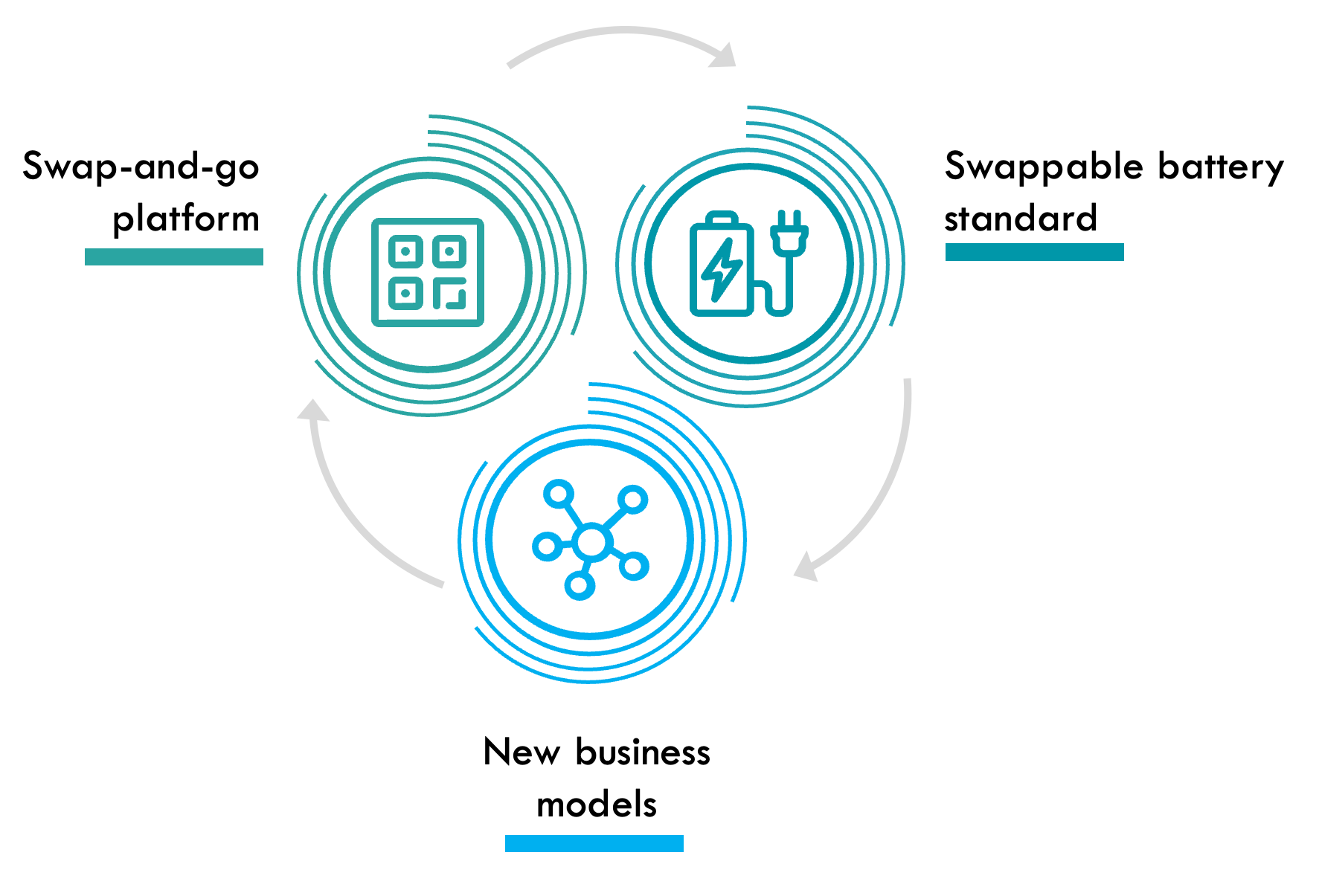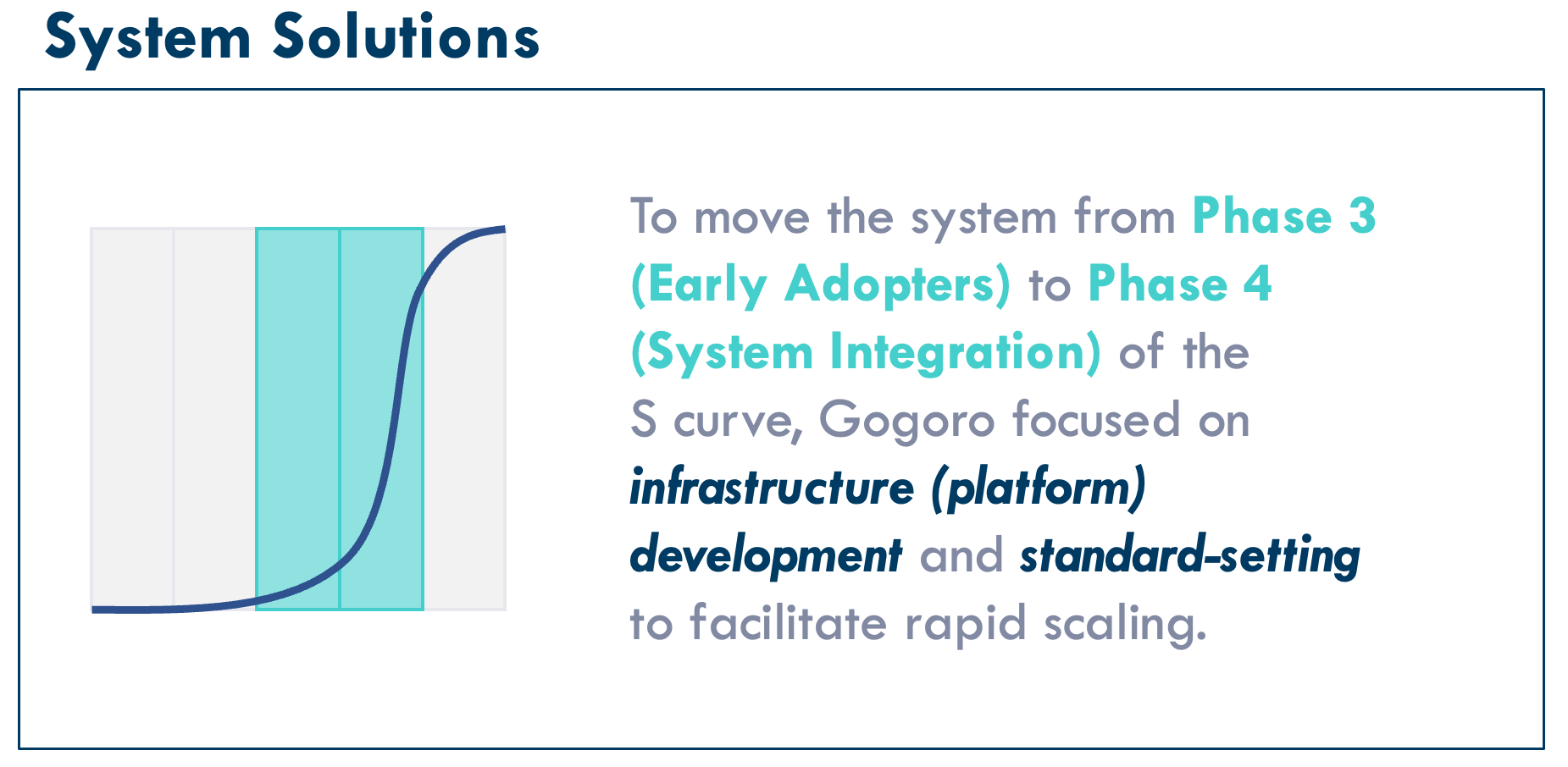
Emergence Strategy in Action: Gogoro Seizes Opportunity in the Transition to Sustainable Mobility
Case study: How did Gogoro go from stealth startup to global battery-swapping leader in just over a decade?
This is the first in a series exploring emergence strategy. For related case studies, click here.
How did Gogoro go from stealth startup to being the largest worldwide provider of light EV battery swapping — all in a little over a decade? The company, which vastly simplifies the charging experience for the rapidly growing two-wheeled electric scooter market, now operates in nine countries.
Gogoro’s success story has all the hallmarks of emergence strategy, including deft system sensing to identify strategic opportunities aligned with its vision and a flexible partnership strategy to increase the company’s influence in a rapidly evolving business ecosystem.
At almost every turn, Gogoro has outpaced bigger potential rivals by taking strategic decisions based on an understanding of the unique role that the company could play in relation to other actors in the system, consistent with the company’s long-term vision for increasing sustainability through mobility.
One factor that has no doubt played a role in shaping Gogoro’s approach to strategy is the fact that the company’s CEO, Horace Luke, spent a formative decade of his career as a creative director at Microsoft. Helping to launch new products including Xbox and Windows XP, he learned how to build an ecosystem of manufacturers, distributors, and retailers centered around a shared platform, rather than a proprietary product.
“What I learned at Microsoft is that you can’t conquer the world by yourself,” Luke says. “You need to build with others and leverage each other’s strengths if you want to revolutionize the world.”
At Gogoro, Luke turned his attention to addressing the urgent need for sustainable mobility solutions in the world’s fastest-growing economies. His take on the climate crisis: “We’ve got to do something now. We can’t lean too late into that turn and just spin of control.”
Shaping a transition in sustainable mobility
Luke’s insight into systems transformation, and his direct experience in shaping transitions, has been well-suited to the kind of business thinking that is needed now to respond to the far-reaching economic changes that are emerging from the energy transition.
But what are the key strategic elements that have defined Gogoro’s success? What lessons do they imply for successful emergence strategies undertaken by other companies?
To begin with, Gogoro focused on a must-win segment for meeting climate and urban air-quality goals: upgrading and electrifying two-wheeled urban scooters. Millions of riders across Asia’s fastest-growing cities and elsewhere around the world use these vehicles for commuting and making deliveries. Gogoro’s solution, announced with fanfare at the 2015 Consumer Electronics Show, was its Smartscooter, an elegantly designed electric scooter that could do zero to 30 in 4.2 seconds, with a top speed of 60 mph.
Beneath the surface, Gogoro laid a foundation for high performance, best-of-class efficiency, and continuous improvement for its vehicles with a combination of technical innovations, including all-digital drive systems, over-the-air firmware updates, and a connected, onboard operating system for data gathering and performance optimization. These investments in Gogoro’s technology platforms were deliberately engineered to future-proof the company’s competitiveness at the level of batteries, vehicles, and charging systems.
So far so good. Gogoro committed the table stakes investments needed to make the customer happy. But what differentiated Gogoro’s business strategy and drove its success over time amid a crowded field was something else. It was a combination of systems-level innovations that rapidly vaulted the company through the often-challenging thresholds at Phase 3 of the S curve (early adopters) and into Phase 4 (system integration at mass-market scale).
Building a sustainable competitive advantage
The three system-level innovations that Gogoro applied all fit together to solve a single problem. Electric scooters are quiet, clean, and cost-competitive (especially on a life-cycle basis), but vehicle charging can impose costly additional burdens on users. These burdens include accessing or owning charging equipment and grid interconnection, physical space for vehicle charging, and time to charge.
Gogoro implemented three interlocking system solutions to solve the customer’s problem, transform this segment of the mobility system, and create a sustainable competitive advantage for the company. Together, these innovations opened the door to a rapidly scaled, ultraconvenient system of battery swapping for users of two-wheeled electric scooters.
Swappable battery standard
First, Gogoro developed a standard specification for swappable batteries that could be used in its own vehicles and in those produced by other manufacturers. Gogoro moved quickly to encourage other manufacturers to adopt the standard, which provided a number of attractive features, including data collection protocols and possibilities for future adoption of alternative battery technologies such as solid-state chemistries. Panasonic, LG Energy Solution, and Samsung are Gogoro’s current partners for battery cells.
Soon after Gogoro launched its scooter network in Taiwan, it recruited other partners to use the Gogoro battery platform. Soon Yamaha, Suzuki, Aeon, and other vehicle manufacturers began to adopt Gogoro’s battery standard. Ten vehicle makers now offer 47 models across Korea, Japan, China, Taiwan, Indonesia, Germany, France, and India using Gogoro’s standard.
The network was designed and implemented as an open network. Today, five out of the top six electric scooter makers in Taiwan use Gogoro Network battery swapping, and Gogoro’s batteries power 90 percent of all electric scooters in Taiwan. There are more Gogoro Network battery-swapping locations than gas stations across Taiwan’s major cities, with more than 1 million batteries in service there.
New business models
Second, Gogoro implemented new business models aligned to the systems transformation it aimed to deliver. One of these was a customer-facing battery-as-a-service business model for vehicle owners that provides convenient access to Gogoro’s network of battery-swapping stations.
A second was the GoShare model, offering instant access to shareable electric two-wheelers. Subscribers can ride as far and as long as they like, swapping batteries in seconds as needed at sites along their routes. Within the first year, the GoShare pilot in Taiwan became one of the fastest-growing sharing platforms in the world, 1 million subscribers and 95 percent fleet utilization daily, with 70 percent of users providing battery swaps on their own.
Gogoro also created a virtual power plant (VPP) business model to provide valuable ancillary services to electric grid operators by managing power flows at its battery swapping stations. Gogoro’s stations in Taiwan have a collective storage capacity of nearly 2 gigawatt-hours.
Partnering with Enel X, an energy services provider, Gogoro is now integrating 2,500 of its GoStations in Taiwan, with capacity of about 150 megawatt-hours, into Enel X’s VPP to deliver services into Taiwan Power Company’s ancillary services market. This service, in turn, aligns with the challenge of integrating increasing shares of renewable energy into the grid, thereby driving down power sector emissions and reducing indirect emissions from electric vehicles.
Swap-and-go platform
The third component of Gogoro’s approach is its physical battery-swapping platform, which uses big data, AI, and machine learning to connect an entire ecosystem of smart vehicles, energy, and services for its users.
Gogoro’s battery-swapping platform provides its now-famous “six-second swap” for 540,000 riders in Taiwan alone at 12,000 battery-swapping stations. Since launching, Gogoro riders have made more than 480 million swaps and have saved upward of 670,000 tons of CO2. For 85 percent of all users in Taiwan, the nearest swapping station is at most a five-minute ride away.
Systems thinking
The systems view reminds us that most true platform businesses experience positive returns to scale. The larger they get, the lower the cost of service, and the higher the competitive barriers to entry. Gogoro knew that battery swapping was likely to be a winner-take-all game and that the path to rapid scaling would come through savvy partnerships with other manufacturers.
The space wasn’t without competitors. Honda developed a swappable battery standard that was arguably as good as or better than Gogoro’s on its technical merits. But whereas Honda recently announced the installation of five swapping stations for its batteries in India, Gogoro recently announced new partnerships in India, South Korea, and the Philippines to roll out swapping networks at scale with local partners. In India alone, Gogoro’s joint venture with Belrise Industries aims to mobilize $2.5 billion in investment over eight years for construction of swapping networks in 10 cities in the state of Maharashtra, starting with Mumbai.
Viewed through the lens of emergence strategy, Gogoro’s story offers a case clinic in how systems thinking can guide companies’ strategic decisions. At nearly every turn, Gogoro made choices that would advance the pace of system transformation. The company knew it couldn’t do it by itself, but it was able to put itself in a position to guide and benefit from the emergence of a diverse ecosystem of service providers in the two-wheeled electric scooter market.
Emergence strategy in action
While Gogoro’s leaders might not have had emergence strategy in mind as a framework for their thinking, the company’s approach aligns closely to the three basic steps we have identified in an emergence strategy approach:
- System sensing. Gogoro’s system sensing identified two-wheeled electric scooters as a solution that could address customer needs while also meeting urgent air-quality and carbon-emissions objectives in many of the world’s fastest-growing economies. Viewed through the top-down lens, numerous studies of low-carbon pathways for improving urban mobility in emerging markets show a key role for electric two- and three-wheelers, especially for first- and last-mile transportation and urban deliveries. From the bottom-up lens, these vehicles are now highly cost-competitive with fossil fuel alternatives, while offering additional performance and customer satisfaction benefits.
- System solutions. As a company moving through Phases 3 and 4 of the S curve, from building a base of early adopters to system integration at scale, Gogoro’s tactics were always focused on market growth. Key decisions with respect to a battery standard amenable to use by multiple manufacturers and design of a battery-swapping platform and business model helped to speed the growth of the market and thereby the company.
- System roles. Leaders can then look at what role the company can play as a leader, catalyst, advocate, or collaborator in a system transformation. Gogoro played the role of catalyst in an emerging business ecosystem around electric scooters in Taiwan. Early on, with the high flexibility that is characteristic of a startup but with low system influence, the company worked strategically with partners to create greater scale and impact for its new products and services than it could have achieved by itself. This strategy helped it grow faster than larger competitors.
Overall, the emergence strategy approach offers a process for integrating systems thinking into a company’s corporate strategy development, with a focus on sustainable solutions. This approach is especially useful where climate imperatives are driving, or have the potential to drive, fundamental change in a sector or industry. Companies at the forefront of change may want to use these types of systems tools to assess and pursue strategic opportunities in concert with their overall strategies for climate and sustainability.



